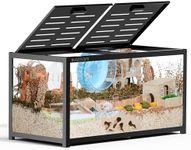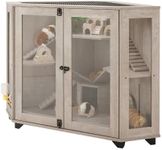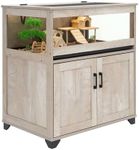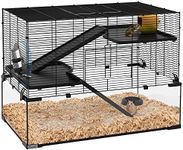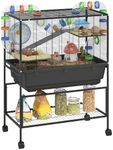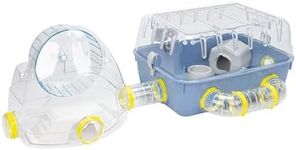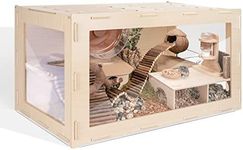Buying Guide for the Best Hamster Cages
Choosing the right hamster cage is crucial for the health and happiness of your pet. A good cage provides a safe, comfortable, and stimulating environment for your hamster. When selecting a cage, consider the size, material, ventilation, ease of cleaning, and additional features that can enhance your hamster's living experience. Understanding these key specifications will help you make an informed decision and ensure your hamster thrives in its new home.SizeThe size of the cage is one of the most important factors to consider. A larger cage provides more space for your hamster to explore, exercise, and play, which is essential for their physical and mental well-being. Generally, a minimum of 360 square inches of floor space is recommended for a single hamster. If you have more than one hamster or a larger breed, you may need an even bigger cage. Ensure the cage has enough room for a wheel, toys, and other accessories without feeling cramped.
MaterialHamster cages come in various materials, including wire, plastic, and glass. Wire cages offer excellent ventilation and are easy to clean, but make sure the bars are close enough to prevent escapes. Plastic cages can provide a more enclosed environment, which some hamsters may prefer, but they need adequate ventilation to prevent respiratory issues. Glass tanks are sturdy and escape-proof but can be heavy and harder to clean. Choose a material that balances safety, ease of maintenance, and your hamster's comfort.
VentilationProper ventilation is essential to prevent the buildup of ammonia from urine, which can cause respiratory problems for your hamster. Wire cages typically offer the best ventilation, while plastic and glass cages require additional considerations to ensure adequate airflow. Look for cages with plenty of openings or mesh panels to promote good air circulation. If you choose a plastic or glass cage, make sure it has a well-ventilated lid or side panels.
Ease of CleaningA clean cage is vital for your hamster's health, so consider how easy it will be to clean the cage you choose. Wire cages with removable trays are generally the easiest to clean, as you can quickly remove and replace bedding. Plastic cages with multiple compartments may require more effort to clean thoroughly, while glass tanks can be cumbersome to handle. Look for cages with easy access points, such as large doors or removable sections, to simplify the cleaning process.
Additional FeaturesAdditional features can enhance your hamster's living environment and make the cage more enjoyable for both you and your pet. Look for cages with built-in tunnels, platforms, and exercise wheels to provide mental and physical stimulation. Some cages come with modular designs that allow you to expand and customize the layout. Consider your hamster's personality and activity level when choosing features, and ensure there is enough space to accommodate them without overcrowding the cage.
